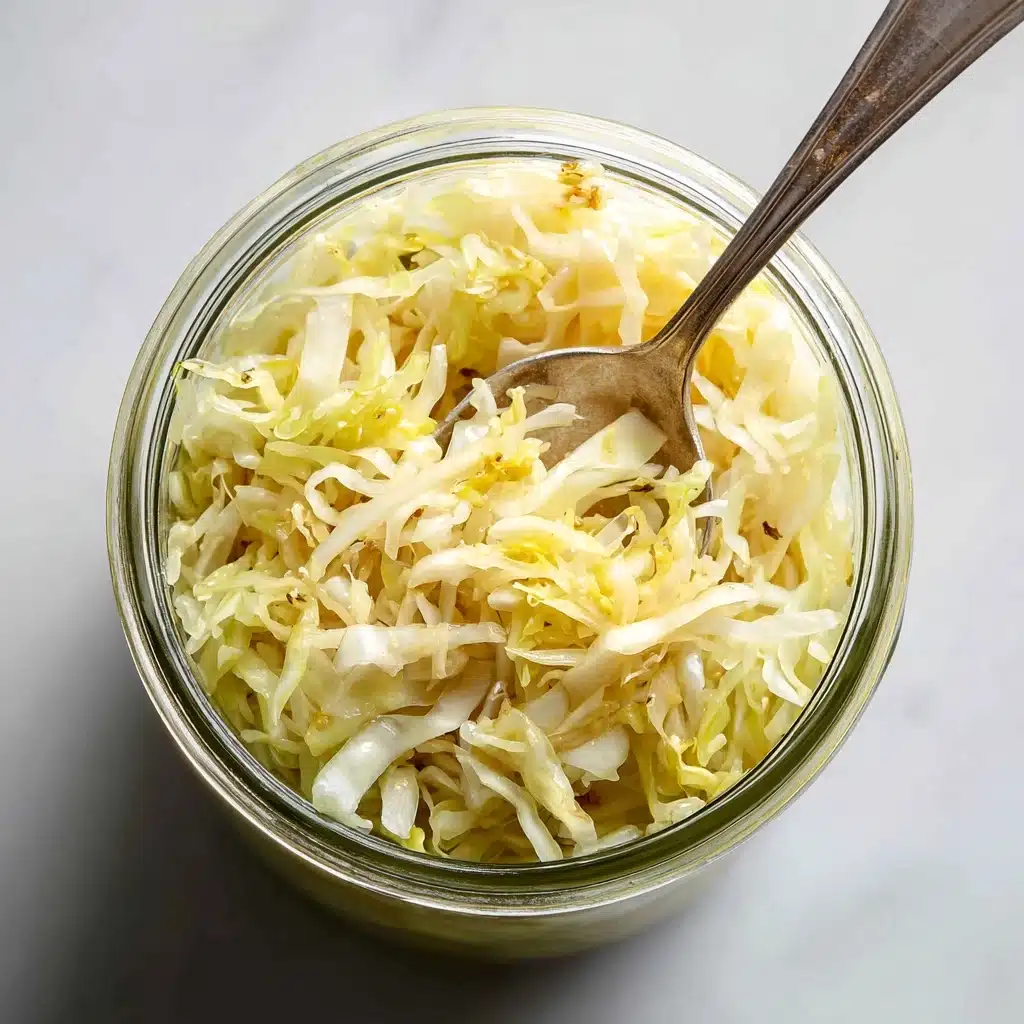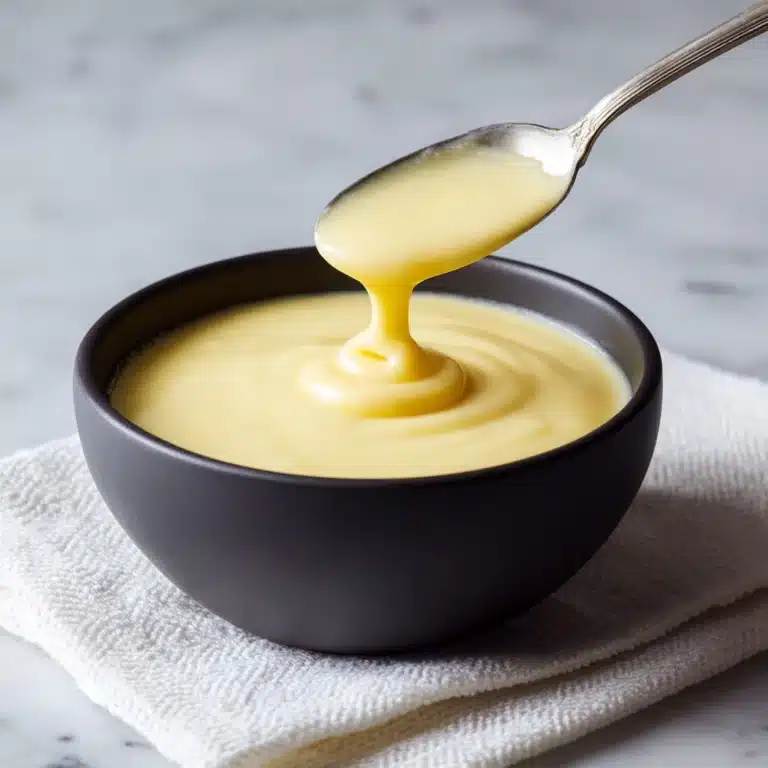If you’ve ever wondered how to achieve that perfectly tangy, crunchy, and irresistibly fresh taste of real Homemade Sauerkraut, you’re in for a treat. Imagine vibrant green cabbage transformed simply with salt and a little patience, resulting in a probiotic-packed, flavor-bursting condiment that’s as nourishing as it is delicious. Making sauerkraut at home demystifies the process and puts you in control of flavor, fermentation, and satisfaction. This classic technique invites you to connect with tradition while filling your kitchen with the wholesome scent of a time-honored German staple.
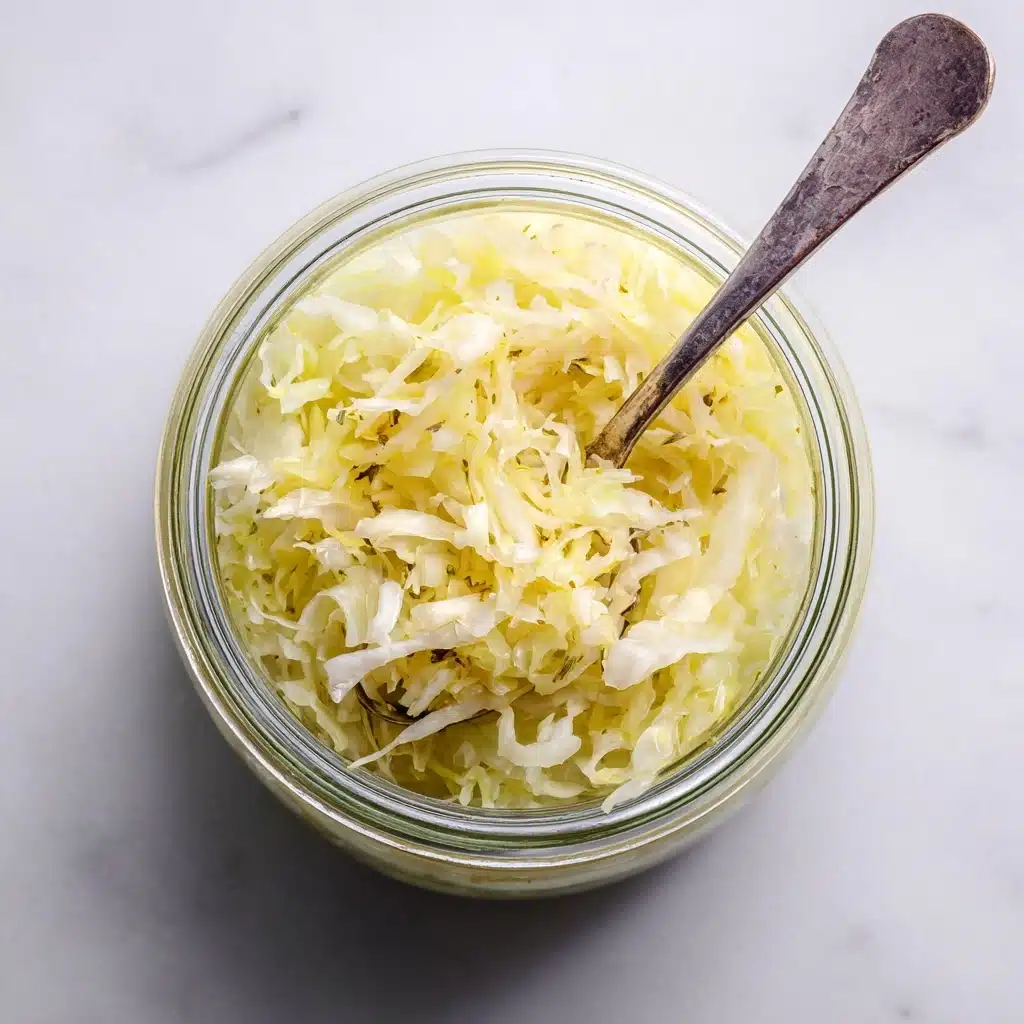
Ingredients You’ll Need
Homemade Sauerkraut comes together with a beautifully short list of ingredients, yet each one plays a starring role in its transformation. With fresh, crisp cabbage, just the right salt, and optional caraway for a hint of warm spice, you’ll see firsthand how simplicity yields a flavor powerhouse.
- Green Cabbage: The heart and soul of Homemade Sauerkraut, choose a medium head—about 3 pounds—for optimal balance of sweetness and crunch.
- Kosher or Sea Salt: Use 1 1/2 tablespoons; non-iodized salt ensures a happy, active fermentation environment and deep, developed flavors.
- Caraway Seeds (optional): Just a teaspoon adds aromatic depth, reminiscent of classic deli-style sauerkraut, so feel free to customize to your taste!
How to Make Homemade Sauerkraut
Step 1: Prepare the Cabbage
Start by removing the outer leaves from your cabbage and set one clean leaf aside for later. Cut your cabbage into quarters and slice out the dense core. Using a sharp knife or beloved mandoline slicer, thinly slice the quarters into slim ribbons—this ensures your Homemade Sauerkraut will ferment evenly and have that satisfying crunch in every forkful.
Step 2: Salt and Massage
Transfer your cabbage shreds into a large, sturdy mixing bowl and shower them with salt. Now comes the magic—use your hands to massage, squeeze, and almost knead the cabbage for 5 to 10 minutes. As you work, you’ll feel the cabbage soften and soon see salty brine forming at the bottom; that liquid is key for the fermentation process.
Step 3: Add Caraway Seeds (Optional)
If you’re after that unmistakable deli flavor, sprinkle in your caraway seeds at this point and give everything a good stir to distribute them throughout. Their gentle pop of warm, earthy flavor brings another dimension to your Homemade Sauerkraut.
Step 4: Pack and Submerge
Grab a sparkling-clean fermentation crock or a wide-mouthed glass jar. Pack a handful of cabbage in, then press it firmly down with your fist or a wooden spoon. Continue adding and pressing until all cabbage is tightly packed and brine rises above the surface. Lay the reserved cabbage leaf over the top as a protective “blanket,” tucking the edges down.
Step 5: Weight and Cover
Top with a fermentation weight or a clean, smaller jar to make sure all the cabbage stays beneath its brine (no peeking above the surface!). Loosely cover your vessel with a clean cloth or specialized fermentation lid—this lets natural gases escape and prevents dust from sneaking in.
Step 6: Ferment
Set your jar on the counter away from direct sunlight. For the next 1 to 3 weeks, check it daily to see that the cabbage remains submerged and skim off any little bits of surface mold if needed—that’s perfectly normal! After about a week, take a tiny taste; ferment longer if you crave a bigger tang. When your Homemade Sauerkraut reaches your ideal flavor, move it to the fridge to slow the fermentation and preserve its fresh crunch.
How to Serve Homemade Sauerkraut
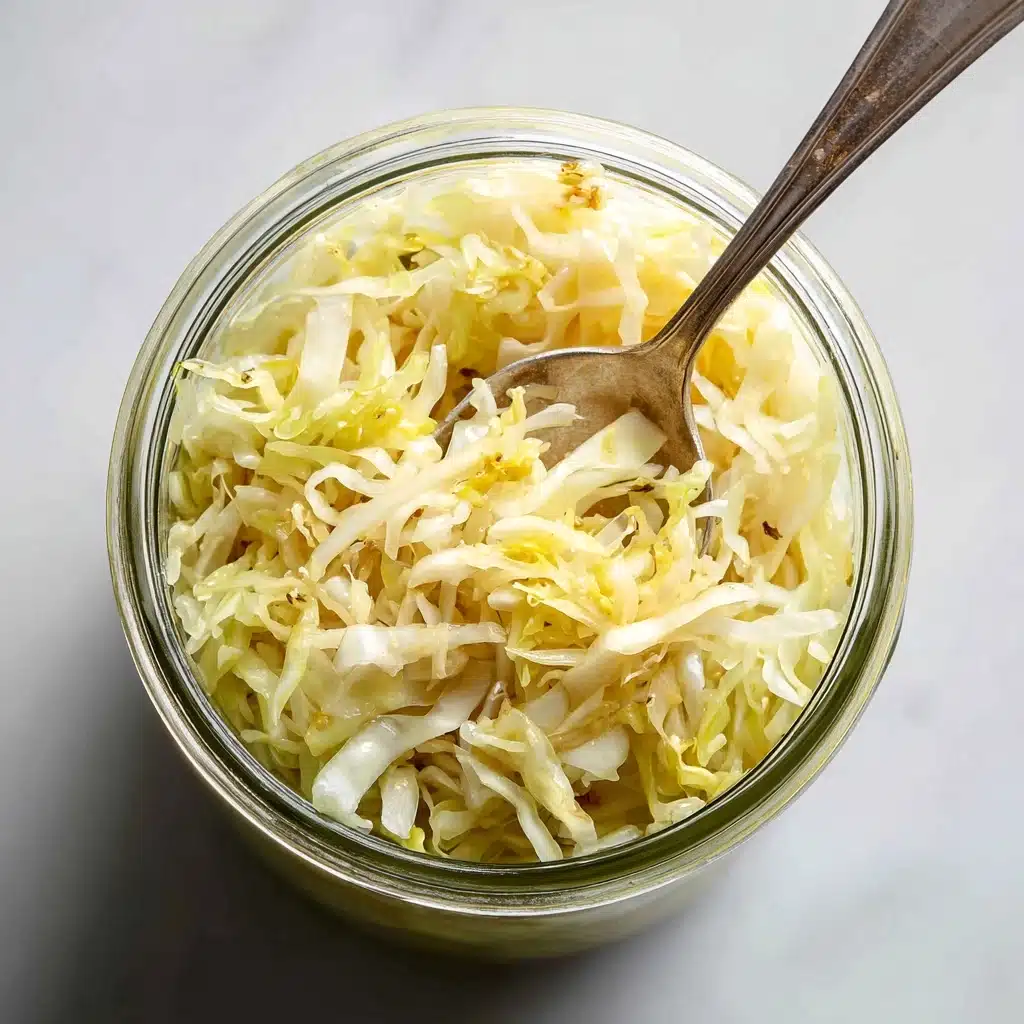
Garnishes
A dollop of Homemade Sauerkraut is already a vibrant accent, but you can make it even more inviting with sprigs of fresh dill, a twist of cracked black pepper, or a drizzle of extra virgin olive oil for a lush finish. For extra visual pop, a scatter of sliced radishes or chives looks beautiful against the pale cabbage crunch.
Side Dishes
Partner your sauerkraut with everything from grilled bratwurst and roasted sausages to potato pancakes or a savory lentil stew. Its tangy freshness is the ideal counterpoint to rich meats and starchy sides, and it breathes new life into a simple sandwich or grain bowl.
Creative Ways to Present
Tuck Homemade Sauerkraut into tacos for a zingy, probiotic boost, layer it on avocado toast, or serve small nests atop crostini with smoked salmon as a flavor-forward appetizer. You can even sprinkle it over salads for a lively snap, or add it to Buddha bowls for dazzling color and crunch.
Make Ahead and Storage
Storing Leftovers
Once your batch of Homemade Sauerkraut hits that perfect note of sourness, pop the jar in the fridge tightly sealed. Cool storage slows the fermentation, letting you savor its flavor and crunch for months—just remember to use a clean utensil each time to keep the brine happy and contaminant-free.
Freezing
Did you know you can actually freeze sauerkraut? The texture might soften slightly, but it’s a handy trick for meal prep. Just pack extra portions in airtight bags or freezer-safe jars, leaving a bit of headspace for expansion, and thaw overnight in the fridge whenever cravings strike.
Reheating
While most Homemade Sauerkraut fans adore it cold or at room temp, you can gently warm it for cooked dishes. To preserve its probiotic power, avoid boiling; instead, heat it on low in a pan just until warmed through, and add to stews or pierogi without simmering too long.
FAQs
Can I use red cabbage instead of green?
Absolutely! Red cabbage makes for a stunning magenta kraut with a slightly bolder earthiness. The fermentation process is the same, so feel free to swap colors for a striking twist on Homemade Sauerkraut.
What if white film or mold forms on top?
This is a common occurrence and is usually just harmless yeast. Simply skim it off with a clean spoon and make sure the cabbage stays submerged in brine. If you notice strange odors or pink/black mold, discard and start fresh.
How long will Homemade Sauerkraut last in the fridge?
Stored in a tightly sealed container and kept refrigerated, your kraut can last for 3 to 6 months or even longer. Its flavor will slowly intensify as it ages, so enjoy tasting the evolution!
Is it normal for bubbles to form during fermentation?
Yes, bubbling and fizzing are signs of healthy fermentation! It means the natural bacteria are working hard to create that crave-worthy tang and crispness in your Homemade Sauerkraut.
Can I reduce the salt or use a salt substitute?
Regular salt is essential for a safe, successful ferment since it inhibits spoilage microbes. Avoid reducing it too much or using substitutes, which can impact both the flavor and safety of your sauerkraut.
Final Thoughts
There’s just something special about making Homemade Sauerkraut from scratch—it’s easy, rewarding, and impossibly delicious. Whether you’re new to fermenting or looking to perfect your kitchen craft, give this recipe a try and savor the difference only homemade can offer. Your future meals and your taste buds will thank you!
Print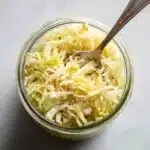
Homemade Sauerkraut Recipe
- Total Time: 1 to 3 weeks and 20 minutes
- Yield: About 1 quart 1x
- Diet: Vegan, Gluten-Free
Description
Learn how to make your own tangy and probiotic-rich sauerkraut at home with this simple recipe. Homemade sauerkraut is a delicious and healthy fermented condiment that adds flavor and beneficial bacteria to your meals.
Ingredients
Cabbage
- 1 medium green cabbage (about 3 pounds)
Salt
- 1 1/2 tablespoons kosher salt or sea salt
Optional
- 1 teaspoon caraway seeds
Instructions
- Prepare the Cabbage – Remove the outer leaves of the cabbage, reserving one. Cut the cabbage into quarters, remove the core, and thinly slice it.
- Massage the Cabbage – Place the sliced cabbage in a bowl, sprinkle with salt, and massage for 5-10 minutes until it wilts and releases juices. Add caraway seeds if desired.
- Pack the Cabbage – Pack the cabbage tightly into a fermentation crock or jar, pressing down firmly. Place the reserved leaf on top to submerge the cabbage.
- Ferment – Cover with a weight, loosely cover, and ferment at room temperature for 1-3 weeks, skimming mold if needed.
- Store – Taste after 1 week and refrigerate to slow fermentation.
Notes
- Use non-iodized salt for better fermentation.
- Keep cabbage submerged to prevent spoilage.
- Prep Time: 20 minutes
- Cook Time: 1 to 3 weeks
- Category: Fermented Condiment
- Method: Fermentation
- Cuisine: German, Eastern European
Nutrition
- Serving Size: 2 tablespoons
- Calories: 10
- Sugar: 1g
- Sodium: 200mg
- Fat: 0g
- Saturated Fat: 0g
- Unsaturated Fat: 0g
- Trans Fat: 0g
- Carbohydrates: 2g
- Fiber: 1g
- Protein: 1g
- Cholesterol: 0mg
